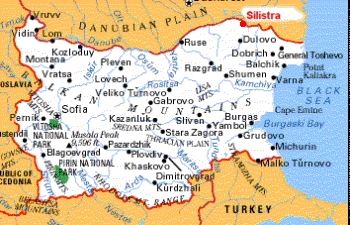 SKC Films Library |
| SKC Films Library >> General and Old World History >> Balkan Peninsula >> Bulgaria |
| Silistra A municipality located in the northeastern part of Bulgaria, on the southern bank of the Danube River, in the Silistra District.
The municipality covers approximately 200 square miles (516 square kilometers), and has a population of about 68,000. There are 19 populated places within the municipality, including the town of Silistra itself, which serves as the administrative center of the district, and 18 villages -- Aydemir, Babuk, Bogorovo, Bradvari, Bulgarka, Glavan, Kalipetrovo, Kazimir, Polkovnik Lambrinovo, Popkralevo, Profesor Ishirkovo, Sarpovo, Smilets, Sratsimir, Sreburna, Tsenovich, Vetren, and Yordanovo. In 29 A.D., the Romans built a fortress on the site of an earlier Celtic settlement called Durrostorum. A substantial city grew up around the fortress, with Roman-built water delivery systems, drainage systems, streets laid out in a gridlike pattern, villas, baths, and all the other amenities of Roman life, and it was for over three centuries one of the most important towns in this part of the Roman Empire. After the fall of the Roman Empire, most of the Balkan Peninsula, including what is now Silistra, became part of the Byzantine Empire. Renamed Drustar upon establishment of Bulgaria in 681, the city was defended by the Bulgarian Tsar Simeon against the Magyars and Greeks in 893. Russian Prince Sviatoslav captured the city in 969, but was forced to surrender it to the Byzantines in 971; the Byzantines subsequently renamed the city Theodoropolis, after the reigining empress. Bulgarian rule was restored in the region by Tsar Samuil in 976, but the Byzantines regained control in 1001, and maintained control over the city and surrounding region for the next 180+ years. The city became part of the Second Bulgarian Empire following the Vlach-Bulgarian Rebellion in 1186. In 1388, the city was captured by the Turks under Ali Pasha. A few years later it came into the possession of the Walachian Prince Mircea, but after his defeat by Mahommed I in 1416 it again passed into the hands of the Turks. It was at this time that the city was given its current name of Silistra. Silistra flourished under Ottoman rule, much as it had under Roman rule, becoming one of the most important of all towns on the Danube. A Greek metropolitan was installed here with five bishops under his control, and the city had a very healthy commercial base. In 1810 the city was surrendered to the Russians, who destroyed its fortifications before they withdrew. The fortifications were rebuilt, however, and in 1828-1829 the city was able to mount a serious resistance to the Russians, who retook the city at the cost of 3,000 men. The city was then held in pledge by the Russians for payment of a war indemnity, and finally returned to Ottoman control in 1836. Silistra became part of the autonomous Principality of Bulgaria as a result of the peace treaty ending the Russo-Turkish War of 1877-1878, and of the Kingdom of Bulgaria in 1908. Following the Second Balkan War of 1913, the city and an area within an 1.8-mile (3 kilometer) radius around it, along with the whole of Southern Dobruja, were awarded to Romania. Bulgaria regained the city during World War I by way of the Treaty of Bucharest (1918), in which Romania surrendered to the Central Powers, but the Treaty of Neuilly (1919) gave it back to Romania. The Axis-sponsored Treaty of Craiova (1940) returned Silistra to Bulgaria, and that transfer was subsequently confirmed by the Paris Peace Treaties of 1947. The city has remained part of Bulgaria since. SEE ALSO |
| SKC Films Library >> General and Old
World History >> Balkan Peninsula >> Bulgaria This page was last updated on September 21, 2017. |
